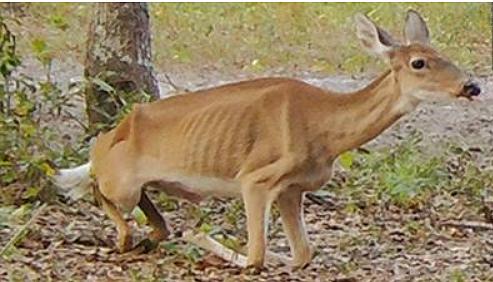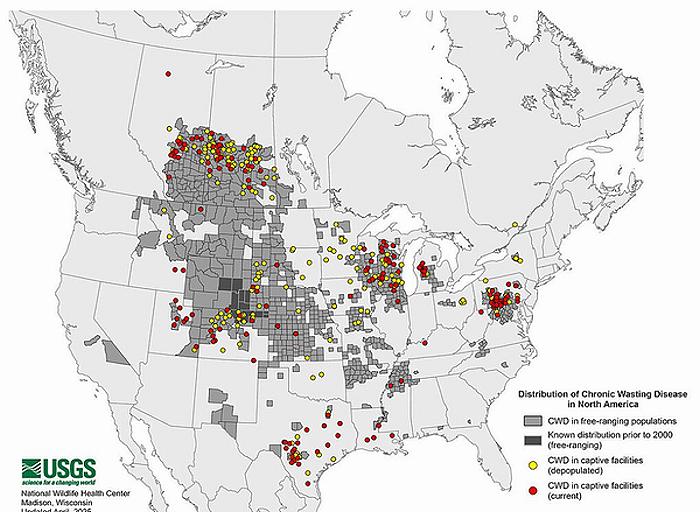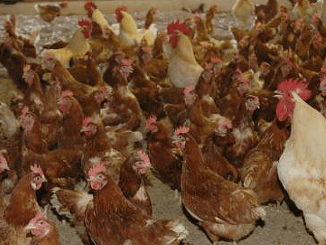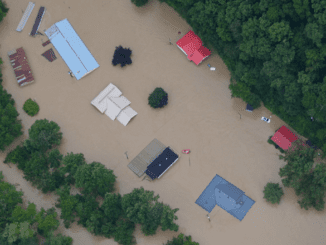FRANKFORT, Kentucky, November 2, 2025 (ENS) – In Kentucky, a second wild deer has been confirmed with chronic wasting disease, a fatal neurologic disease that infects deer, elk and moose. Officials with the Kentucky Department of Fish and Wildlife Resources announced on Wednesday that the dreaded disease was confirmed in a wild deer taken by a hunter in south-central Kentucky’s Pulaski County.
Like mad cow disease, chronic wasting disease is caused by abnormal proteins called prions. Both diseases are caused by these infectious, misfolded proteins that damage brain tissue. Both diseases are progressive, fatal, and currently have no cure or vaccine.
Both diseases are transmitted through direct contact with an infected animal or indirect contact with contaminated bodily fluids such as saliva, urine, feces, or fleshy tissues.
Both diseases cause symptoms related to neurological damage, such as stumbling and weight loss.
Other prion diseases include scrapie in sheep and goats, and Creutzfeldt-Jakob disease in humans.

Chronic wasting disease is not known to be transmissible to people, but as a precaution the U.S. Centers for Disease Control and Prevention, recommends that people not consume meat from deer that test positive for the disease. Kentucky Fish and Wildlife always recommends not consuming meat taken from animals that appear to be sick or in poor condition.
In this case, two independent types of tests were performed on tissue collected from a 2.5-year-old male white-tailed deer. Both tests yielded the same result – the deer was infected with the abnormal proteins that cause Chronic Wasting Disease.
Chronic wasting disease was previously confirmed in a wild deer in Ballard County in December 2023.
Then there were the cases that erupted in Kentucky’s captive deer. Nine deer from a captive cervid facility in Breckinridge County have been confirmed with the disease, with one discovered in October 2024 and another eight in August 2025.
The disease spreads easily through the environment from infected deer droppings, urine and saliva.
History of Accelerating Chronic Wasting Disease
In the United States, chronic wasting disease was first detected in a captive deer facility in Colorado in 1967 and, since then, has spread to almost every place that these facilities operate.

It was first found in free-ranging elk in the 1980s and has now been identified in captive and wild cervids across 36 U.S. states – 17 states have joined that list in the last 10 years alone.
The only prion disease known to affect free-ranging wildlife, CWD is increasing in prevalence in areas where the disease is already established. In heavily affected areas of Wyoming, Colorado, and Wisconsin, more than 40 percent of free-ranging cervids are infected, the USGS finds.
As Kentucky Fish and Wildlife staff continue to gather more details about the infected deer, agency officials are in close communication with national, state and local partners and will reference the agency’s CWD Response Plan in response to this new detection.
As part of the response plan, the agency will schedule a public meeting in Pulaski County in November to discuss the disease, available CWD testing options and any potential hunting regulation changes.
In addition, an update on CWD and suggested actions will be brought before the Kentucky Fish and Wildlife Commission for their review at the commission’s planned quarterly meeting on December 5, in the state capital city, Frankfort.
Since 2002, Kentucky Fish and Wildlife has CWD-tested more than 70,000 deer and elk from across the state.
“Routine and regular sample collection has been a key component in monitoring the health of our deer and elk herds,” Wildlife Division Director Ben Robinson said. “While this detection of CWD is not in close proximity to the other detections, we will work with hunters and partners to try to contain it.”
Fourteen counties near the previous positive detections make up the CWD Surveillance Zone. Ballard, Breckinridge, Calloway, Carlisle, Fulton, Graves, Hardin, Henderson, Hickman, Marshall, McCracken, Meade, Union and Webster counties are under carcass transportation and baiting restrictions in an effort to monitor and contain CWD.
Hunters in Henderson, Union and Webster counties also must take their harvested deer to a staffed check station or use a CWD Sample Drop-Off Site the first three days of modern gun season.
Hunters can help Kentucky Fish and Wildlife’s statewide monitoring efforts by dropping off the heads of legally harvested and telechecked deer for CWD testing and aging at self-serve CWD Sample Drop-off sites or via sample mail-in kits. This service is provided at no cost to hunters.
Detailed location information, instructions and additional resources may be found at the CWD Sample Drop-Off Sites and CWD Sample Mail-in Kit webpages on the department’s website. Hunters will be promptly notified if a deer they harvested tests positive for CWD.
Deer that appear to be sick but do not have an obvious injury can be reported using the department’s sick deer online reporting form; reports will be reviewed by the agency’s wildlife health program staff, who may contact the person submitting the report if additional information is needed.
Hunting Helps Control Chronic Wasting Disease
Hunting greater numbers of male deer can slow the spread of chronic wasting disease, a lethal wildlife disease, according to a new study by the U.S. Geological Survey and the Wyoming Game and Fish Department.
“We found that harvesting a high proportion of the adult males in the herd – around 40 percent every year for 20 years, is expected to keep chronic wasting disease infections at low numbers,” said Wynne Moss, lead author and USGS scientist.
If this high level of hunting pressure is applied consistently over 20 years, less than five percent of the males on average are expected to be infected. On the other hand, a lower level of hunting pressure, such as 20 percent of adult males harvested per year, would result in a much higher prevalence of around 30 percent infected.
For more information on CWD, please visit the department’s Chronic Wasting Disease webpage and follow its social media channels. More information about CWD is available through the CDC and cwd-info.org websites. For questions, contact the department’s Information Center at 800-858-1549, or at info.center@ky.gov, weekdays 8 a.m. to 4:30 p.m. ET, except holidays.
Featured image: Deer with chronic wasting disease in Kentucky. 2019 (Photo courtesy Kentucky Department of Fish and Wildlife)
© 2025, Environment News Service. All rights reserved. Content may be quoted only with proper attribution and a direct link to the original article. Full reproduction is prohibited.



